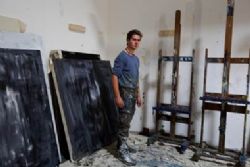WILLIAM FOYLE
SELF PORTRAITS
Following two highly acclaimed solo exhibitions in London, this young artists’ work was met with very considerable success at Ross’s in Belfast. The exhibition in the May Street rooms closed on Friday 27th October after brisk selling.
The son of an English Hungarian father and an Irish mother, William Foyle spent regular periods in Antrim and Donegal absorbing the landscape and the ever changing light. As a professional painter, Foyle has an intellectual approach to his work and travels extensively in Europe visiting museums and galleries and drawing on the experiences and people that he meets.
William Foyle has successfully shown in solo exhibitions at two London galleries, Gallery 8, Duke Street, St. James’s and The Royal College of Art, but perhaps the greatest endorsement of his work is a picture purchased in 2016 by the distinguished Ruth Borchard Self Portrait Collection. Foyle’s work is held in collections in the USA, France, Monaco, Ireland, Switzerland, Germany, Austria, Spain and the UK.
Professor Maurice Cockrill RA, Keeper of the Royal Academy of Arts (2005-2011) commented, “There is a quality and meaningfulness in these varied works by William Foyle who shows considerable talent and promise. Portrait heads executed in vigorous and vibrant impasto reveal an assurance with the materials and methods of painting that he is rapidly developing”.
Sir Timothy Clifford, Director of the National Galleries of Scotland (1984-2006), writing of William in 2012 hailed him as ‘one to watch’.
William Foyle was born in 1993 and lives and works in London.
Art historian Dickon Hall wrote this note on the exhibition:
The apparent simplicity of the self-portraiture conceals one of the most complex genres in which an artist works, one which has many motivations and which establishes a very particular relationship between the artist and the viewer.
This exhibition by William Foyle is made up of a group of self-portraits, most of which were completed over a short period of around twelve months, forming a particularly intense and revealing process of self-analysis. Nearly every image concentrates solely on the artist’s head, pushing it into direct confrontation with the viewer on a lifelike scale. There are rarely other distractions, such as studio props or compositions that include a fuller figure, to distract from the intensity of this engagement.
Yet there are constantly shifting dynamics across this series of paintings, drawings and prints, evoking particular associations and suggesting an accompanying change in their mood. The artist’s own frustration with the unavoidably slow narrowing-in on the single ideal image can be sensed throughout the exhibition as he moves closer to us or further away, or stares back from a new angle as if trying to see something that has not yet been captured on the sheet or canvas.
There are a range of media used and some images appear to be quickly, spontaneously achieved, while at other times a slower accumulation of the paint surface demonstrates another change in Foyle’s method. Occasionally there is more concern to create a likeness, which is then almost obliterated in other works. But the control evident across these self-portraits, the awareness of mark-making and the relationship of the image to the mark, is particularly striking given the artist’s age at the time.
This is a direct and highly personal body of work, a journey to which the viewer is drawn in, and which also demonstrates a great interest in the history and the nature of self-portraiture itself.

